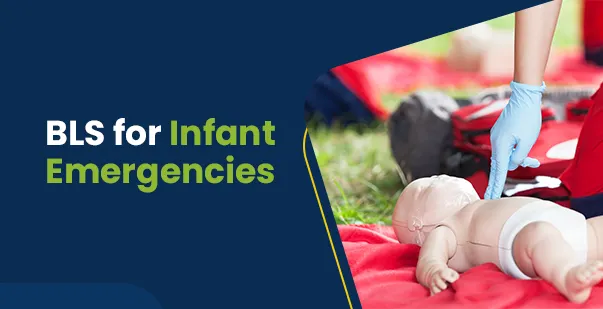Every year, out-of-hospital cardiac arrests (OHCA) occur in children at a rate of approximately 8 to 10 cases per 100,000 people. The survival rates of such cases are between 2% to 9.6%. In such critical moments, how a parent or caregiver responds can make all the difference.
Infant Basic Life Support (BLS) teaches essential, life-saving steps to keep a baby’s heart and lungs functioning until emergency medical help arrives. Unlike adult BLS, infant BLS takes into account a baby’s smaller, more delicate body. The techniques are gentle but effective.
If you’re a parent, guardian, or someone who spends time with babies, learning infant BLS isn’t just a smart decision, it is an important step toward an infant’s safety. Still wondering what kind of emergencies can happen or what you’ll actually learn in BLS training? Keep reading to discover real-life scenarios, essential techniques, and why BLS is a must-have skill for every caregiver.
Master BLS Now
Get BLS certified with confidence
What Is Basic Life Support?
A life-saving technique used to help someone experiencing a medical emergency, like cardiac arrest or choking, is BLS. Chest compressions, rescue breaths, and the use of an Automated External Defibrillator (AED) are taught during the course. These steps keep blood and oxygen flowing to vital organs until professional medical help arrives.
Infant BLS is customized to meet their unique needs and fragile physiology. Unlike adults, infant BLS uses gentler techniques, such as two-finger chest compressions and softer rescue breaths. It emphasizes proper positioning of the infant’s head and body to prevent further complications.
Read More: Pals coupon code
Common Infant Emergencies
Infants are vulnerable to sudden medical emergencies due to their developing bodies and limited ability to communicate. Recognizing the most common emergencies early can help parents and caregivers respond quickly and effectively. The following are the common reasons why infants are unresponsive:
-
Choking
Choking is one of the most common emergencies in infants. Babies are naturally curious and often put objects, toys, or food into their mouths. Small items like buttons, coins, or even pieces of food can block their airway, making breathing hard for them. Signs of choking include coughing, gagging, or complete silence if the airway is fully blocked. You need to act quickly by using back blows and chest thrusts to remove the object and restore normal breathing.
-
Breathing Difficulties
Infants have small, delicate airways and underdeveloped lungs, making them prone to breathing problems. Conditions like asthma, infections, or allergies can lead to difficulty breathing. Common symptoms include fast breathing, wheezing, or flaring nostrils. In severe cases, their lips or skin may turn bluish. Immediate attention is needed to prevent the situation from worsening.
-
Sudden Cardiac Arrest
Although rare, infants can experience sudden cardiac arrest due to congenital heart defects or respiratory issues. In this situation, an unresponsive infant in cardiac arrest will show no signs of breathing or movement. Signs include unresponsiveness and no breathing. In such a situation, start CPR immediately to increase their chance of survival.
-
Drowning
Infants can drown in as little as one inch of water. This can happen during bath time or if they’re left unattended near water sources. Even small household items like buckets or toilet bowls can pose a serious risk if left uncovered. Always empty water containers immediately after use and keep bathroom doors closed to prevent drowning accidents. In addition, supervise infants around water to avoid this from happening.
BLS Techniques for Infants
Every year, around 7,000 children in the U.S. suffer out-of-hospital cardiac arrest, with infants under one year facing the highest risk. Choking ranks as the fourth leading cause of unintentional death in kids under five. These numbers are alarming, but the right response can change the outcome. So why not equip yourself with the best BLS techniques for infants?
-
Performing Infant CPR
Infant CPR is used to restart the heart and support breathing. Use two fingers to provide compressions at the center of the chest. Compressing about 1.5 inches deep at a rate of 100-120 compressions per minute. Deliver rescue breaths by gently covering the infant’s mouth and nose with your mouth and blowing air in.
-
Relieving Choking
Infant choking is a common emergency, and BLS training teaches how to alternate between five back blows and five chest thrusts to remove the blockage. These techniques can save a baby’s life when their airway is obstructed. In addition, back blows help dislodge the object by creating pressure, while chest thrusts provide an additional push to clear the airway. It’s important to support the infant’s head and neck during these actions to avoid injury.
-
Using an AED on Infants
Use Automated External Defibrillators (AEDs)on infants during cardiac arrest. Training includes using pediatric pads or AED settings to deliver safe and effective shocks and restart the baby’s heart. Proper pad placement, one on the chest and one on the back ensures the electrical shock travels through the heart. The AED provides voice prompts, guiding the rescuer through each step for accurate use.
-
Maintaining an Open Airway
Position the infant’s head well to keep the airway open. BLS for infants explains how to tilt the head slightly to ensure effective breathing or ventilation. The head tilt-chin lift technique is gentle and prevents the tongue from blocking the airway. This step is especially important when providing rescue breaths during BLS infant CPR.
Read More: A Parent’s Guide to First Aid
Pediatric BLS Algorithm
The Pediatric BLS/BLS infant algorithm is a step-by-step guide to help save a baby’s life during an emergency. If you find an infant in cardiac arrest, the next step is to check for responsiveness and breathing, then start CPR right away. Following these steps quickly can improve the baby’s chance of survival.
-
Safety of Rescuer and Victim
Always make sure the area is safe before you begin. Look for hazards like traffic, fire, or sharp objects that might hurt you or the child. If the area is dangerous, carefully move the child to a safer place before starting CPR. Protecting yourself ensures you can help without becoming a victim too.
-
Assess the Need for CPR
Quickly check if the child needs unresponsive infant CPR by looking for movement or normal breathing. Gasping or irregular breaths do not count as normal breathing. If there’s no response and no proper breathing, start CPR immediately. Acting quickly gives the child the best chance of survival.
-
Check for Response and Breathing
Tap the child gently and speak loudly to see if they respond. Watch their chest to see if it rises and falls, listen for breathing sounds, and feel for airflow from their nose or mouth. If there’s no response and no signs of normal breathing, act without delay. Every second counts in an emergency.
-
Start Chest Compressions
If the child doesn’t respond or breathe, begin chest compressions. For infants, use two fingers to press the center of their chest, while for children, use one or two hands depending on their size. Push hard and fast, compressing about 1.5 inches for infants and 2 inches for children at a rate of 100-120 compressions per minute. Proper depth and speed are crucial to helping their heart pump blood.
-
Open the Airway
Tilt the child’s head back slightly to open their airway, being gentle to avoid injury. For infants, cover both their nose and mouth with your mouth; for children, pinch their nose and breathe into their mouth. Deliver two slow breaths, watching for the chest to rise each time. This helps provide oxygen to their body and brain.
-
Chest Compressions and Breathing Coordination
If you’re the only rescuer, alternate 30 chest compressions with two breaths. If there’s another rescuer, switching rules during infant CPR is recommended. This ensures that one person does not get tired and the compressions are effective. Switch to 15 compressions and two breaths to reduce fatigue and improve the child’s chance of survival if there are two rescuers. Make sure your movements are smooth and continuous to keep blood and oxygen flowing.
-
Activate Emergency Response System
If help hasn’t already been called, make sure it’s done as soon as possible. Call 911 or your local emergency number, or ask someone nearby to do it while you continue CPR. If you’re alone, perform CPR for about two minutes before leaving the child to call for help. Early activation of emergency services ensures advanced medical care is on the way.
Read More: Difference Between An Adult, Infant And A Child CPR
Preventing Infant Emergencies
The best way to keep infants safe is to prevent emergencies before they happen. Always supervise them, especially during meals and playtime, to reduce the risk of choking. Babies are naturally curious and may put small objects in their mouths, so keep a watchful eye on them.
Baby-proofing the home helps prevent accidents. Small items like coins, buttons, or tiny toy parts should be kept out of reach. Dangerous substances such as cleaning supplies and medications must be stored in locked cabinets.
Safe sleep practices are also necessary for infant safety. Babies should always sleep on their backs in a crib with a firm mattress. Loose bedding, pillows, and stuffed toys should be avoided to lower the risk of suffocation. In addition, all caregivers should learn CPR and first aid. If caregivers know how to respond to emergencies, then parents and guardians can be at peace.
Handle Infant Emergencies With Correct BLS Techniques!
Basic Life Support (BLS) for infants is one of the most important skills parents, caregivers, and teachers can have. Emergencies like choking, breathing problems, or cardiac arrest can happen suddenly, and responding quickly can save a baby’s life.
Technological advancements in the future will make infant BLS more easier. You can learn it through online courses, interactive simulations, and improved tools like smart AEDs. We can ensure more infants receive the care they need in emergencies with wider awareness and better access to training.
References:







